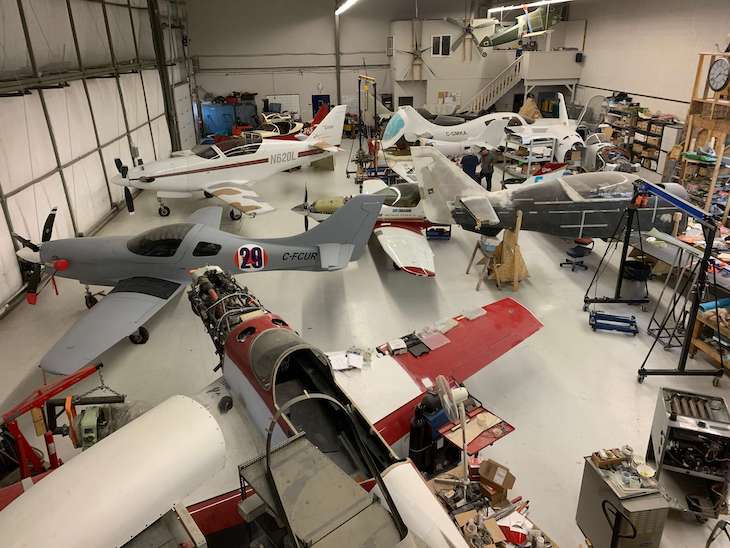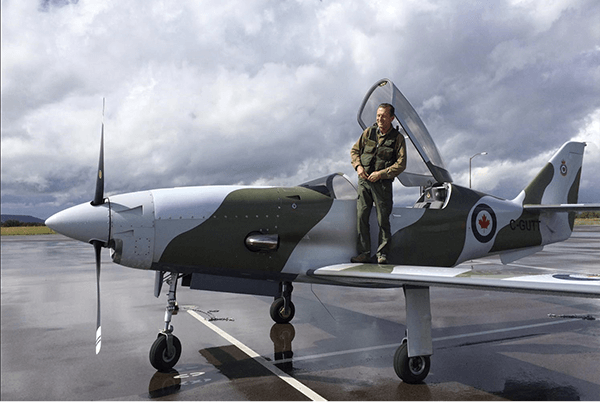Two SAIT aviation grads can build you an airplane

Local aviation company builds and enhances custom high-performing turbine aircrafts.
When airplane enthusiast and former Royal Canadian Air Force pilot Marty Abbott reached out to Shane Daly (Aircraft Maintenance Engineers Technology ’98) and Bob White (Aircraft Structures Technician ’00) for help building a hobby plane, he knew the two friends— who met at SAIT— would be up for the unique request.
As a long-time supporter of SAIT’s aviation programming, Abbott was confident the two would have the technical expertise needed to help with his Legend Aircraft kit — a homebuilt, two-person and single-engine turboprop plane.
“I was told they trained at SAIT and were brilliant craftspeople,” says Abbott.
“I’d followed the SAIT aviation programs for years and knew other graduates. After connecting, I felt confident they’d have great breadths of knowledge in aircraft construction and maintenance.”
Clear skies ahead for Daly and White’s new company Innovative Wings to take shape.
“Once we got Marty’s airplane to the point where it was ready to fly, we brought it out to the Springbank Airport, where other people saw it. And work just kept coming — the company just continued. That was 23 years ago,” says Daly. “The original intent was that I was going to build Marty’s plane and go back to my day job. That never happened.”

Up, up and away
Innovative Wings takes on experimental work from custom avionics, such as full electrical builds and control panel conversions to manufacturing complex metalwork or mechanical aircraft components. Their willingness to take on unique requests means they are working on anything from big budget builds to one-off modifications. After outgrowing their original space three years ago, they moved the company to another Springbank Airport facility three times the size — a clear reflection of the reputation they’ve built on the global stage.
“We have clients from Australia and New Zealand, around the U.S. and across Canada. We’re even working with a client in Venezuela. It is a small industry and we’re able to rely heavily on word of mouth. We do very little advertising beyond a website and some social media,” says White.
While the composite side of building planes doesn’t experience much change, avionics and engine systems are constantly evolving through innovation. Clients will come to Daly and White with new technology that piques their interest and the team will spend time researching the idea to see if it’ll integrate with the modifications already completed on a particular plane.
When asked which project stands out over the course of their work together, Daly and White agree it’s Abbott’s plane.

“It’s iconic,” says White.
The Legend Aircraft is powered by a 1,200-horsepower Garrett Dash 10 engine. It cruises at 350 knots (650 km/h) with a max speed of 400 knots (741 km/h) and climbs at 10,000 feet per minute — outperforming documented speeds of World War II fighter aircrafts. In other words, it’s a testament to the innovative modifications made to similar planes. The one-of-a-kind aircraft has won a handful of AirVenture Cup Races at the Experimental Aircraft Association’s annual fly-in convention, and— according to Abbott— was the fastest single-engine turbine aircraft in the world for a number of years.
“They’ve done a fantastic job building and improving this one-of-a-kind plane over the years. Every summer I bring it back to enhance the aerodynamics — a better fuel system or start system, better avionics,” says Abbott.
With their collaborative approach to modifications, Daly and White bring ideas inspired by other projects because their business is about outside-of-the-box thinking and seeking opportunities for innovation. Sometimes Abbott will suggest a new piece of innovative technology he’s heard about.
That maverick kind of thinking has even brought the team a new speed and agility challenge — this time on ice.
“We’re working with the Canadian Olympic luge team to build their sleds. They are training for the World Championships in Vancouver 2025 and those will be all of our sleds,” says Daly. “This is the first time they’ll have all the same sleds.”
According to both Daly and White, the foundational skills they learned at SAIT helped pave the runway for their career in entrepreneurial aviation.
“My SAIT education gave me a solid base on the structural side of things — the engineering and design — and I’m thankful for that. I still have my textbook from SAIT and open it quite a bit. One of my instructors even gave me my first job out of school,” says Daly.
“The Aircraft Structures Technician program at SAIT taught me the principles directly related to aircrafts and I’ve continued to hone those skills over the last 20 years.” says White.
Let your career take off with the Aircraft Structures Technician program
Learn all aspects of aircraft structure repair to general aviation, corporate, charter, transport category aircraft, and helicopters.
Learn more about the programSkills for the Future
We prepare students for successful careers and lives.
SAIT'S
2020-2025
Strategic plan

Oki, Âba wathtech, Danit'ada, Tawnshi, Hello.
SAIT is located on the traditional territories of the Niitsitapi (Blackfoot) and the people of Treaty 7 which includes the Siksika, the Piikani, the Kainai, the Tsuut’ina and the Îyârhe Nakoda of Bearspaw, Chiniki and Goodstoney.
We are situated in an area the Blackfoot tribes traditionally called Moh’kinsstis, where the Bow River meets the Elbow River. We now call it the city of Calgary, which is also home to the Métis Nation of Alberta.